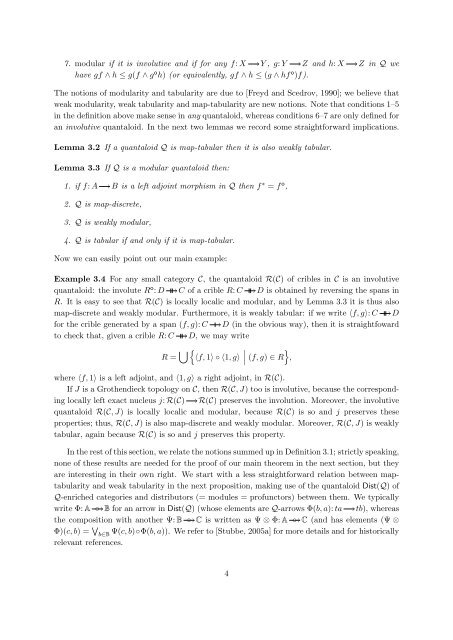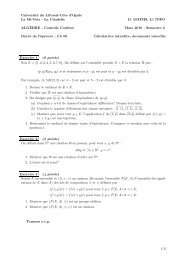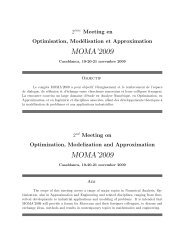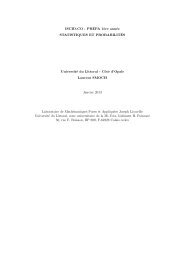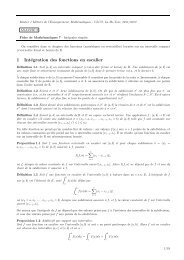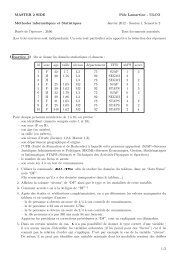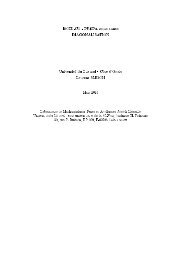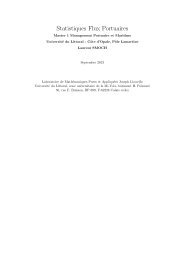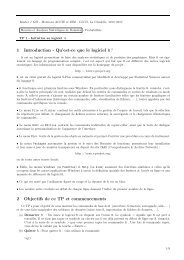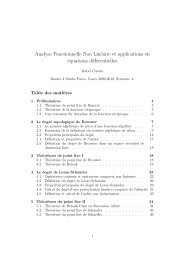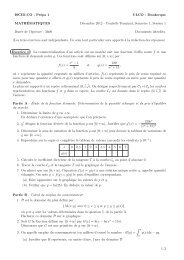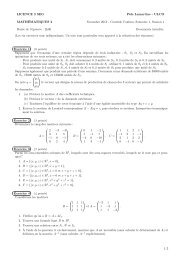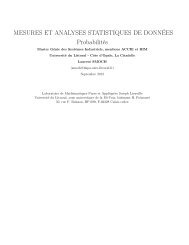download pdf - LMPA - Université du Littoral Côte d'Opale
download pdf - LMPA - Université du Littoral Côte d'Opale
download pdf - LMPA - Université du Littoral Côte d'Opale
You also want an ePaper? Increase the reach of your titles
YUMPU automatically turns print PDFs into web optimized ePapers that Google loves.
7. mo<strong>du</strong>lar if it is involutive and if for any f: X Y , g: Y Z and h: X Z in Q wehave gf ∧ h ≤ g(f ∧ g o h) (or equivalently, gf ∧ h ≤ (g ∧ hf o )f).The notions of mo<strong>du</strong>larity and tabularity are <strong>du</strong>e to [Freyd and Scedrov, 1990]; we believe thatweak mo<strong>du</strong>larity, weak tabularity and map-tabularity are new notions. Note that conditions 1–5in the definition above make sense in any quantaloid, whereas conditions 6–7 are only defined foran involutive quantaloid. In the next two lemmas we record some straightforward implications.Lemma 3.2 If a quantaloid Q is map-tabular then it is also weakly tabular.Lemma 3.3 If Q is a mo<strong>du</strong>lar quantaloid then:1. if f: A B is a left adjoint morphism in Q then f ∗ = f o ,2. Q is map-discrete,3. Q is weakly mo<strong>du</strong>lar,4. Q is tabular if and only if it is map-tabular.Now we can easily point out our main example:Example 3.4 For any small category C, the quantaloid R(C) of cribles in C is an involutivequantaloid: the involute R o : D C of a crible R: C D is obtained by reversing the spans inR. It is easy to see that R(C) is locally localic and mo<strong>du</strong>lar, and by Lemma 3.3 it is thus alsomap-discrete and weakly mo<strong>du</strong>lar. Furthermore, it is weakly tabular: if we write 〈f, g〉: C Dfor the crible generated by a span (f, g): C D (in the obvious way), then it is straightfowardto check that, given a crible R: C D, we may writeR = ⋃ }{〈f, 1〉 ◦ 〈1, g〉 ∣ (f, g) ∈ R ,where 〈f, 1〉 is a left adjoint, and 〈1, g〉 a right adjoint, in R(C).If J is a Grothendieck topology on C, then R(C, J) too is involutive, because the correspondinglocally left exact nucleus j: R(C) R(C) preserves the involution. Moreover, the involutivequantaloid R(C, J) is locally localic and mo<strong>du</strong>lar, because R(C) is so and j preserves theseproperties; thus, R(C, J) is also map-discrete and weakly mo<strong>du</strong>lar. Moreover, R(C, J) is weaklytabular, again because R(C) is so and j preserves this property.In the rest of this section, we relate the notions summed up in Definition 3.1; strictly speaking,none of these results are needed for the proof of our main theorem in the next section, but theyare interesting in their own right. We start with a less straightforward relation between maptabularityand weak tabularity in the next proposition, making use of the quantaloid Dist(Q) ofQ-enriched categories and distributors (= mo<strong>du</strong>les = profunctors) between them. We typicallywrite Φ: A ❝ B for an arrow in Dist(Q) (whose elements are Q-arrows Φ(b, a): ta tb), whereasthe composition with another Ψ: B ❝ C is written as Ψ ⊗ Φ: A ❝ C (and has elements (Ψ ⊗Φ)(c, b) = ∨ b∈BΨ(c, b)◦Φ(b, a)). We refer to [Stubbe, 2005a] for more details and for historicallyrelevant references.4


